Triennials Out of Time: Lagos Biennial and Lubumbashi Biennale
Sammy Baloji and Folakunle Oshun
June 2023
Triennials Out of Time is a series of short conversations featuring artistic directors and curators of cyclical exhibitions organized by James McAnally for the Counterpublic 2023 civic exhibition. Across disparate forms, Triennials Out of Time considers whether the slow build and release of multi-year, cyclical exhibitions may offer a more humane pace that allows proper engagement, inquiry, and reorientation to one’s place and publics. In this fifth conversation, Folakunle Oshun, founding Artistic Director of the Lagos Biennial in Nigeria, speaks with Sammy Baloji, co-founder (with Ghislain “Gulda” el Magambo Bin Ali) of the Lubumbashi Biennale in the Democratic Republic of the Congo.
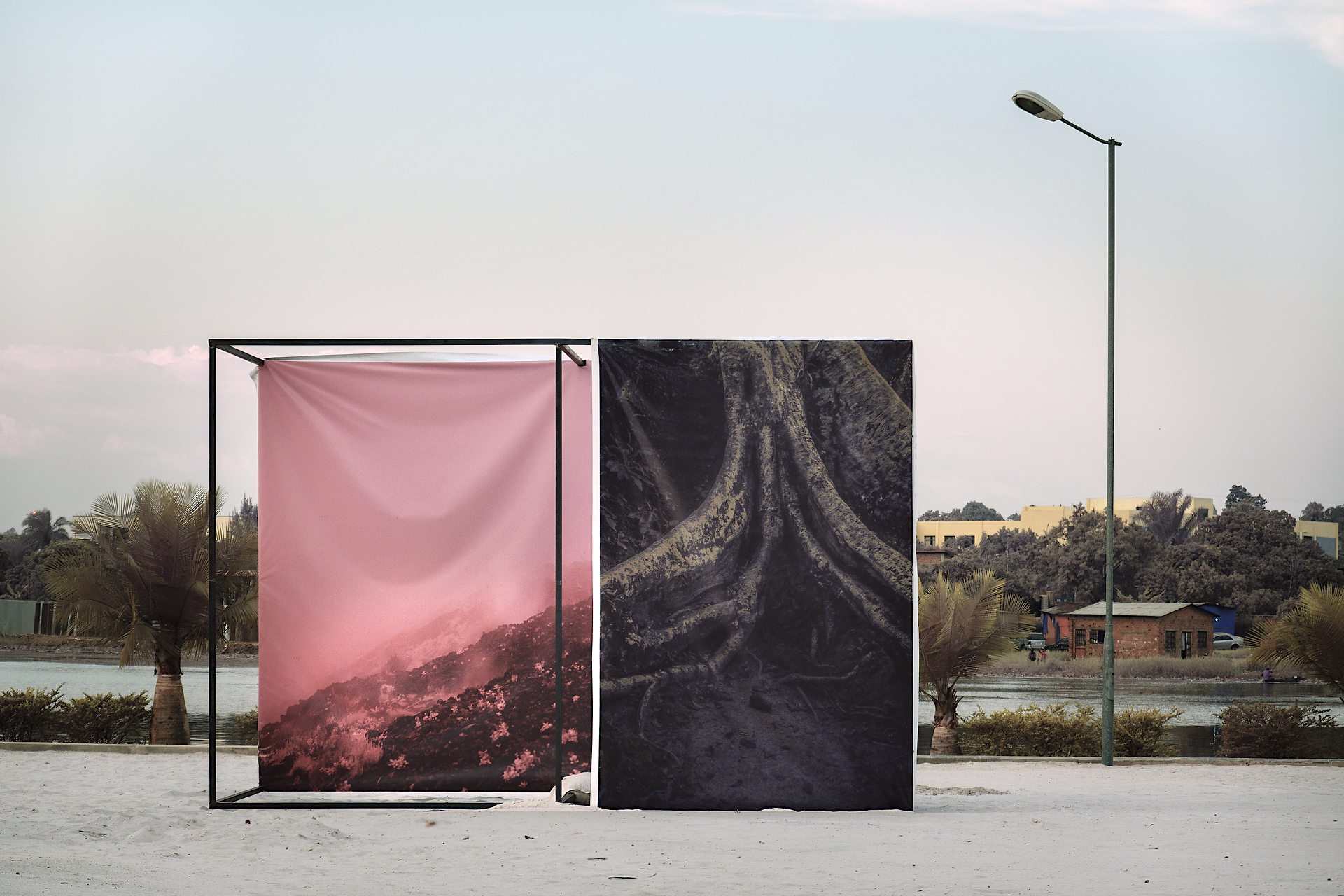
Léonard Pongo, installation view of “Primordial Earth” at the Lubumbashi Biennale 2019, Democratic Republic of the Congo. Courtesy of the artist.
Folakunle Oshun: I wanted to start this conversation with you because on the continent, you are another person who runs a biennial and is also an artist who makes photography, sculptures, and installations. I don’t know your motivation to start a biennial in Lubumbashi, but for me in Lagos, there were very personal reasons as an artist. First, there was the frustration of having to work with institutions and galleries in Lagos, which are super commercial. But also, back in 2012 when I did my master’s program at the University of Lagos, I remember my art history professor asked us to give an account of the just concluded Dakar Biennale – and my mind went blank. I didn’t know what a biennial was. I didn’t know where Dakar was. I then wanted to know: What is this thing? During this same period, I had big discussions online with Bisi Silva [curator and founder of the Centre for Contemporary Art, Lagos (CCA)] who had just come back to Nigeria from the UK. I wanted to know: What is this contemporary art like? It was a moment of introspection in which I started reassessing my channels of creative expression.
After that, I did some work at the African Artists’ Foundation, set up my own studio space, and then showed at the 12th Dakar Biennale in 2016. That was where the whole biennale thing started to make sense: you get a few artists, buy some tickets, put out the theme, and people will show up. So, it was like Lagos was waiting for that. There were already a lot of people interested – there were a lot of different camps (the governments had tried to do it but it just never happened) – and Bisi was having talks at CCA just messing with the idea of a Lagos Biennial, and she invited me for one of those talks. That was the trigger – and the discomfort – but I thought: We can do this. I can do this.
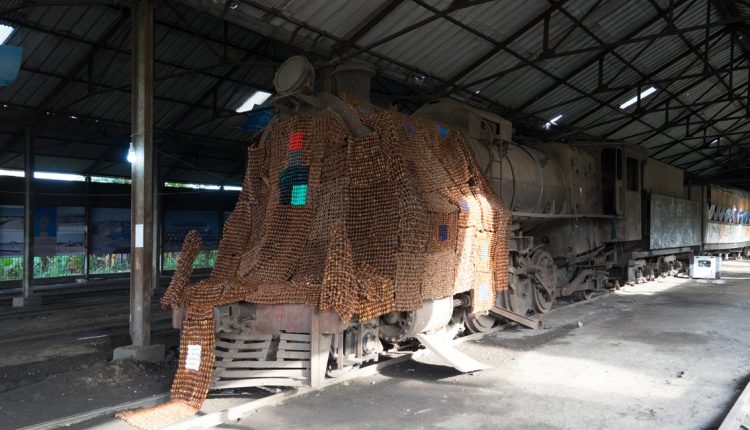
Lagos Biennial 2017 (first edition) Photo: Eva Maria Ocherbauer
I thought the first edition [Lagos Biennial 2017] of this kind of event should really reflect on the immediate environment. So, we came up with a theme, Living on the Edge, which was first looking at the geography of Lagos as a coastal city that becomes the window or the access point of Nigeria (the first British port when they came and a very important trade route) but then also trying to capture the realities of people who live on the edge of society and are eclipsed by the center.
We found a train station that had been in use since colonial times. A lot of the Nigerian railway corporation staff and their families lived in and around the trains in shacks and the like – people living on the edge of their existence – so it just fit. At the time, I didn’t really recognize the contextual historic validity of the space. It was all about aesthetics; anything to look like a biennial – mirroring everything in my little experience that I had seen that looked raw, that looked deep. Then the artists came, and that was when the magic really happened. That’s the most authentic story I can give of how it all started. It was that agitation from Dakar.
Sammy Baloji: It’s somehow the same experience that also brought me to start the Lubumbashi Biennale with a collective of artists. But, first of all, I would just like to point to the fact that [unlike Lagos, which is the former Nigerian capital and the most populous city in Africa] Lubumbashi is the second-largest city in the Democratic Republic of the Congo, while the capital, Kinshasa, is 2,000 kilometers away.
Talking about the Congo, we should also look at the colonial legacy in terms of how the country, in terms of infrastructures, was thought out. For example, Kinshasa before 1960 was a town planned for 400,000 people. Since independence, there hasn’t been any urban planning, and today, there are more than eleven million people living in the city.
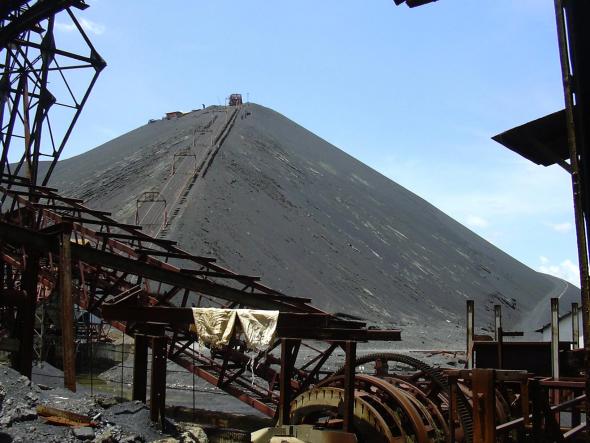
Industrial waste of Lubumbashi factories and slag heap. Photo courtesy of Sammy Baloji.
Also, Lubumbashi is quite particular because it’s part of a province called Katanga that, since colonial times, was a place where they were extracting copper. I was born in Lubumbashi and I grew up in this area knowing the importance of the mining company. We had a big nationally owned company called Gécamines, which still exists today. For example, the uranium that was used for the atomic bomb came from Shinkolobwe, which is near Lubumbashi. So, during the Cold War, it was really important for the United States to keep Congo under control, of course, because of the uranium and because nearby Angola was communist – so, to keep Congo out of a socialist invasion. This is why, for example, [Patrice] Lumumba, the first prime minister of the (Democratic) Republic of the Congo, was executed because after his visit to the United States and failing to get an agreement, he went to visit Moscow.
So, in 1990, at the end of the Cold War, all these dictatorial regimes were no longer interested because the socialist and communist world came to an end and suddenly, it was a period of democracy. In Congo, politicians and people who were against the [Mobutu] dictatorial regime who were in exile or imprisoned suddenly all appeared in order to start to fight back and to create this platform of democracy and freedom of expression. However, these movements were pushed back by Mobutu with the army. Then, we went into a crisis period, and suddenly all this culture and all the collaborations stopped from one day to another. I remember when I was a kid I used to go to the French Cultural Center to get books, but from 1990 to 1997 it wasn’t possible because all the libraries were closed and the city was completely shut down in many ways.
Then, at the beginning of 2000, the country reopened to the world. By that time I had finished studying at the university and started to work for the French Cultural Center, which had opened again as well. I was working as a photographer and I started to work with the director of the French Institute because he was really interested in documenting the mining landscape and the colonial architecture in order to create a fuller memory of the city. Through that project, I started to collaborate with a historian in colonial architecture and anthropologists to document the colonial buildings and the mining heritage. So, this is how I came across all this information related to colonial history, which actually I didn’t learn at school or even at the university. So, for me, this first series was a kind of introspection in terms of what it means to live in a city where part of history has been hidden and where the present is a consequence of what happened before.
This was in 2005. I was twenty-seven years old or so and was invited to present this work at the Smithsonian and in New York, Brussels, and Paris. And after that, I was invited to the Bamako Biennale [Bamako Encounters – African Biennale of Photography] in 2007. For the first time, we were surrounded by African photographers and thinkers. For me, that was a strong moment when I realized that it’s important to do this kind of event also in Lubumbashi.
During this period, Gulda and I came across Simon Jenning, who was the artistic director of this biennial for seven editions. We explained to Simon how huge it was for us to have this experience of being invited and to meet brothers and sisters and all these people that are thinking about a path and a future for our continent. Previously, we didn’t know these kinds of events were happening on the continent, so we thought: Why shouldn’t we think about having this kind of program? Simon advised us to create an association and to ask the government for support.
In talking about this, I would also point to the fact that Lubumbashi is 2,000 kilometers away from the only fine art academy in our country. In Lubumbashi, we only have a secondary school called the Institute of Fine Arts, where kids are trained until they are 18 years old and just really on the technical basics, not all that concerned with theory or art history. Two thousand kilometers away means you have to travel by airplane because there are no roads and no trains that can bring you there. And when you look at people’s incomes, not everyone can afford to pay for kids to fly to Kinshasa to go to school there. My parents were not able to do that for me. So, I didn’t have any fine arts education in my life.
This is my context and the reason why we decided to start the biennial in Lubumbashi. There was an important mission to connect a space where extraction has been going on for centuries to a global economy. There’s propaganda around hiding the truth while also ignoring people that have been colonized.
So, we went back to Lubumbashi and started to work with the French Institute in order to create the event. But we were still trying to get support from our government, and that’s when we realized that our government was not interested in culture at all. Even now, we are not supported by the government. They don’t even know what we are doing.
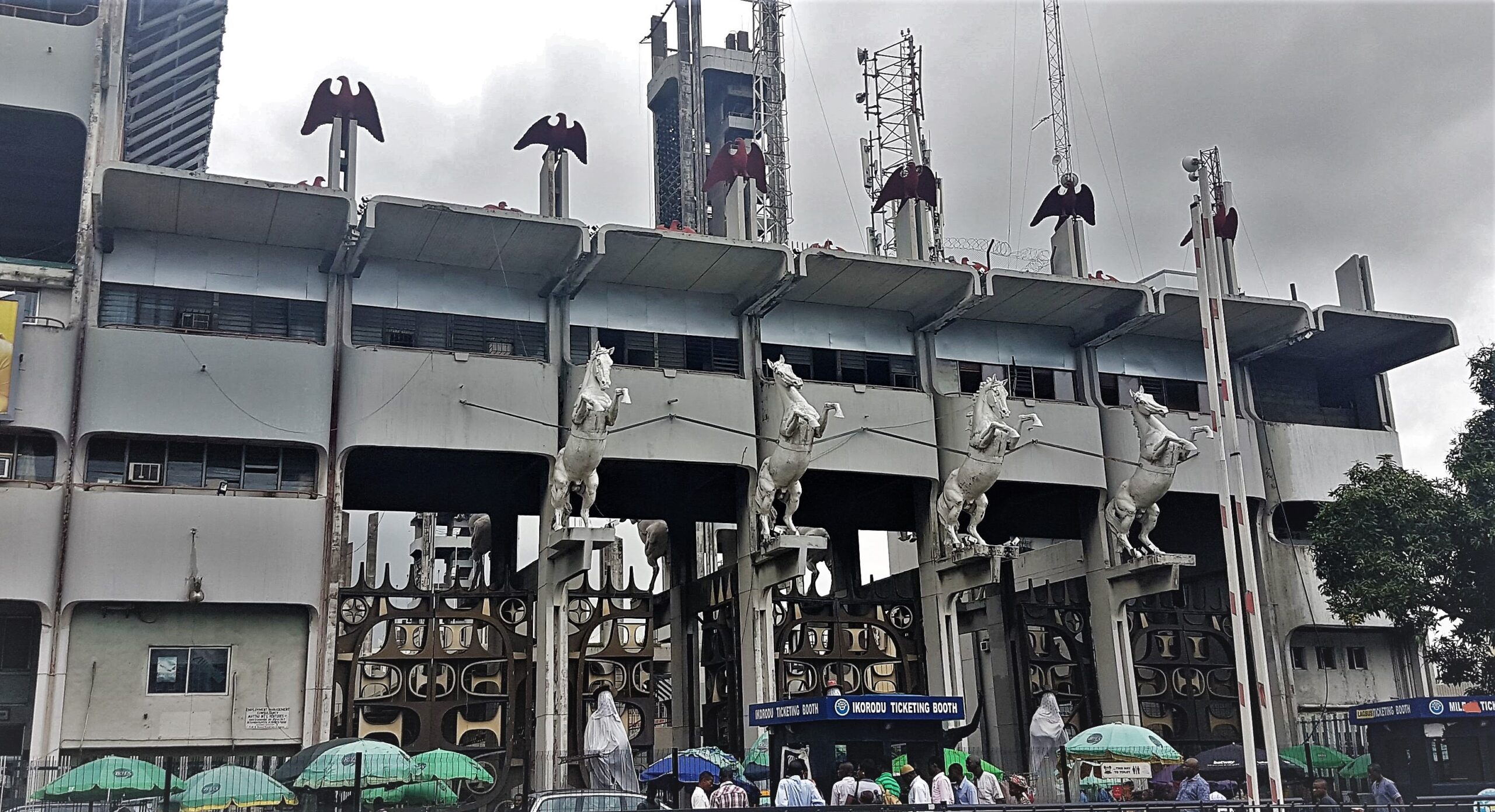
Tafawa Balewa Square, Lagos. Site of Lagos Biennial 2021-23.
FO: It’s great to hear this from someone on the continent. I mean, it’s a similar narrative, but your experience goes deeper in time. And also hearing about your journey starting an artist-led biennial is very important because while there are tons of biennials across Africa – Johannesburg had more government involvement1 and in Dakar, it is actually enshrined in the constitution that they get this funding – it also brings up a question of control.
Honestly, being born in Anglophone West Africa, the Francophone world was always a blind spot, and it was making these road trips alone that started to open my eyes to that other reality. I’m currently living in Paris doing a PhD and trying to really understand this other version of colonial history and how it is represented in this space and the level of non-accountability and erasure. On the one hand, there’s the fact that you wanted to create a platform to investigate the past and to propose new models for the future. On the other hand, there is the organizational structure, the way you described how Simon was advising you at the time. We also used to go to Bisi Silva for consultations, and the first thing she said was: Don’t call it a biennial. At the time, I didn’t understand what she meant by that, but, in hindsight, I totally get it because just adding “biennial” to our name made my life ten times more difficult. It made communication and PR easy, but there were expectations and the government had an eye on us even though they would never support us. How have you been able to sustain the Lubumbashi Biennale for this many years without government involvement?
SB: In all that you’ve been saying, I’ve been thinking about the Congolese philosopher Valentin-Yves Mudimbe’s book entitled The Invention of Africa (1988). He analyzes all the discourses that were produced in order to shape and then control the continent – in a way, all the knowledge that has been produced after the creation of those borders — and also thinking critically about even those Africans producing knowledge that is approved by the West. So, it’s an important topic because the most important question is really to think about the context from which we are talking: Are we talking? Are we creating our expression and our sense of belonging?
You are working from a Nigerian context, so you need to understand what it means for Nigeria because Nigeria was invaded; the borders you have are not the ones that you created. It’s not your communities that have created Nigeria. In Congo, we have nine borders, but in all those borders you have the same communities on both sides. In Angola, you have people who are the same: they are Luanda or they are Chokwe. So, we also need to think about the pre-colonial period and how people were living in those areas.
It’s the same when thinking about independence and where in Africa borders were negotiated. Does it really fit the pre-colonial communities or not? Last year, I did this exhibition, K(C)ongo Fragments of Interlaced Dialogues. Subversive Classifications [at Palazzo Pitti, Uffizi Gallery in Florence, Italy] among works created by Michelangelo and collected by Cosimo I de’ Medici. At that time, they started to categorize what is art and what is not. But one should consider that, at the same time, you already had nobles and kings who had cabinets of curiosity and were receiving diplomatic gifts from all over the world. Some of them were coming from Congo, back in the sixteenth century: you have those ivory oliphants that are part of the Cosimo collections coming from Africa. They were part of one of the first museums in Rome created by this Jesuit German Athanasius Kircher, who was trying to categorize artifacts coming from all over the world and looking at how they carried and produced knowledge.
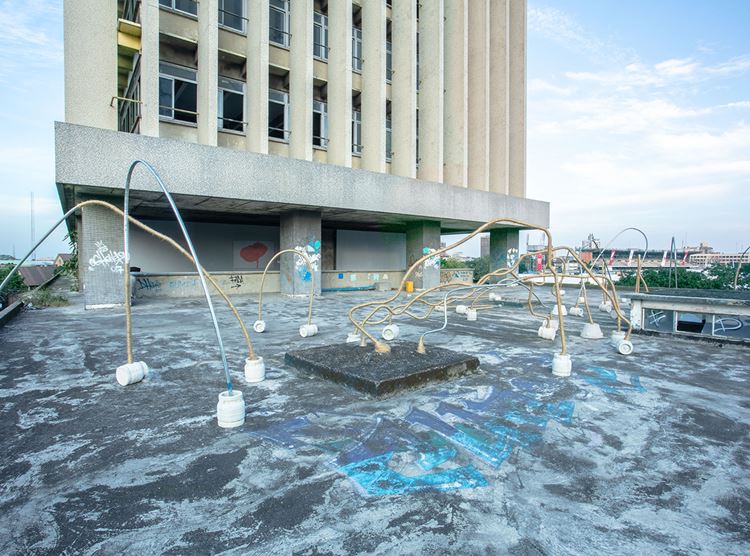
Temitayo Ogunbiyi. “You Will Find Playgrounds Among Palm Trees” (2019), exhibition view at 2019 Lagos Biennial: How to Build a Lagoon With Just A Bottle of Wine? Courtesy of Lagos Biennial.
FO: The problem is that we call it a biennial and there’s that expectation that it has to fit a certain canon.
SB: But I think that’s a trap. Look at the way that, for example, I did this work in Lubumbashi considering how the city was created with this sanitary corridor to separate the Black from the white, which was called a neutral zone. It was calculated to be around 700 meters long. The reason, scientifically, that they were justifying this sanitary corridor was allegedly to prevent a malaria infection coming from the Black area, and the length of the sanitary corridor was calculated by thinking about how far a mosquito can fly. So, even the way that the city was shaped as an urban space is violent because it’s already creating a disruption. And our government is reproducing the same process because it’s not rethinking how to live together in those spaces that were intentionally created to extract benefits from the soil, human resources, and nature. The mining sector is privatized, so you have the Chinese or the Americans who can come and exploit whatever they want and give money to the government, which never goes back to the people.
There’s a sense of defining what community we want to be a part of and what it means to be a part of it. It’s also part of this process of being together and sharing the same space, sharing emotions, and that needs to be done in order to create a safe space to think about the future. So perhaps if you use a biennial, you need to respect the entire process.
FO: Central Africa and the Congo have always been a bit of a blind spot for me because a lot of my education was facing West Africa, and, at best, South Africa, which was a big deal when we were growing up. They used to come to our schools to collect money from students to donate for the freedom of South Africa, from apartheid, and to free Mandela. So, that was the real gaze.
But growing out of that, I’m beginning to form my own research and understand the world and am seeing the kinds of atrocities that were carried out in Congo – but I don’t feel that the artistic work that comes out of that region reveals the extent of the atrocities there. Is it that there’s a level of censorship or intimidation or just a lack of awareness? Because I also don’t think all the atrocities the French committed in Africa compare to what happened with Leopold II in Congo.
SB: I really don’t think that we can go through a comparison. I think it’s distracting because all these colonial enterprises were complementary and competitive. For example, Congo was owned by King Leopold II from 1885 to 1908. It was intended to be a zone for free exchange, which means it was a capitalist space before it was directly a capitalist market. This is what was actually happening with the privatization of the mining sector. So, when you look at the archives, you’ll see there were already American missionaries in Congo as far back as 1890. You had Danish people arriving, Italian soldiers, and you have collaborations with the mining company. You also had capital coming from some British companies and all of that. So, I think it’s wrong to compare one colonization versus another one. It was all, in a way, the same machine, the same people competing with each other, but they were also spying on each other, taking each other’s methods, and thinking about the global market more than the space the colonies were in.
FO: I remember reading somewhere that you were questioning if we are living in the postcolonial, or if Africa is still being colonized. I believe it was a statement you made questioning if these are postcolonial times or if Africa is still under the hold of the West.
SB: My question is: If we are free, why don’t we rethink even those borders? Because they are not part of what our ancestors felt in terms of the relation to the land and negotiating the space. It’s really different from the states we have today. So, if those borders are creating problems even now – I mean, we are at war with Rwanda, for example – and if we are at war with each other through those borders, it’s clear that there’s a problem. How come we are not able to revisit those borders? Because we know when they were invented. They were invented in 1885. Why are they still there?
FO: It’s economical . . .
SB: Not only. But also: Who has this economy in their hands? And, if we can resolve that: Why do we need to “fit in” with what a “biennial” means?
Maybe to finish, I just want to give you an example of the first time they showed African art at the Venice Biennale in 1922. Part of the exhibition was a private collection of an Italian soldier who was enrolled by the Leopold regime to come to Congo at the end of the turn of the twentieth century. When he arrived in Congo, he was seventeen or eighteen years old. He found all this local resistance that was happening at that time, and reports state that he was involved with the killing of Congolese who were part of the resistance. He spent almost thirty years there and he “collected” objects – but you need to think about how he collected them. Were those gifts?
When he returned to Italy, he gave part of his collection to the Museum of Anthropology in Florence. By entering into the museum, they became ethnographic objects. But then suddenly, in 1922, they were shown for the first time in the “Scultura negra” (Negro Sculpture) exhibition at the Venice Biennale and were considered artworks.
And the last thing is that the Belgian pavilion in the Venice Biennale was created by Leopold; it was financed by him and it’s one of the first pavilions at the Biennale – and, of course, the Venice Biennale is the first biennial. From there, we can go to all the world exhibitions where there were human zoos and also those colonies parading as pavilions. So, talking about exhibitions and the roots of exhibition-making: when we are talking about these histories, there is no separation.
Footnotes
- After years of isolation as a consequence of the apartheid system, the Johannesburg Biennale was meant to restore dialogue between South Africa and the international art scene. The first edition took place in 1995, a year after the first free elections. In spite of great international interest, the second edition in 1997 (under Artistic Director Okwui Enwezor) was closed a month ahead of the planned schedule. “Financial problems of the city of Johannesburg” was announced as the official reason. Since then, no further Johannesburg Biennale has taken place. The organizing institution, Africus Institute for Contemporary Art (AICA), has since been dissolved. More information available at: http://universes-in-universe.de/car/africus/english.htm.
Sammy Baloji is an artist and photographer based between Brussels and Lubumbashi. His work mines the memory and history of the Democratic Republic of Congo through the use of archives that he manipulates to highlight the legacy and ongoing impact of the colonial system. He is a cofounder of the Lubumbashi Biennale, which had its seventh edition in 2022.
Folakunle Oshun is an artist and curator from Lagos, Nigeria. His practice engages the relativity of forms and the mapping of orbits and unorthodox spaces. He is the founder and director of the Lagos Biennial, a platform for critical dialogue and the development of contemporary art. He is currently a Ph.D. candidate at École Nationale Supérieure d'Arts de Paris-Cergy where he also lectures.